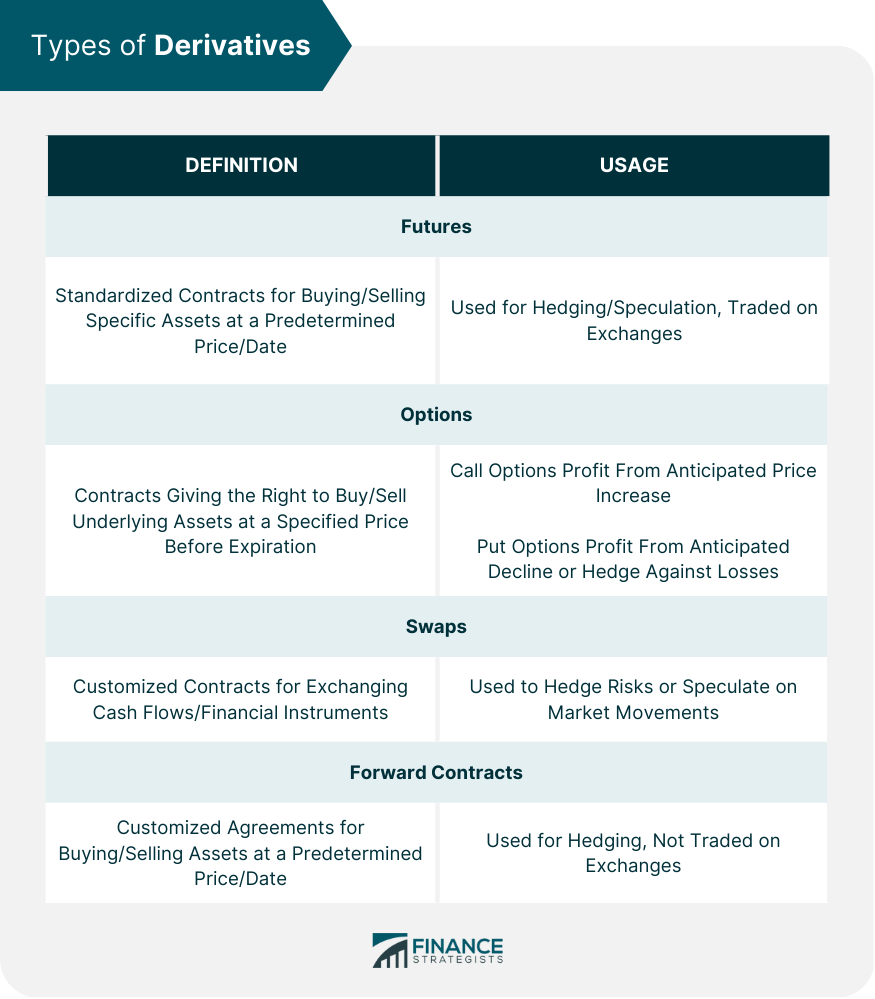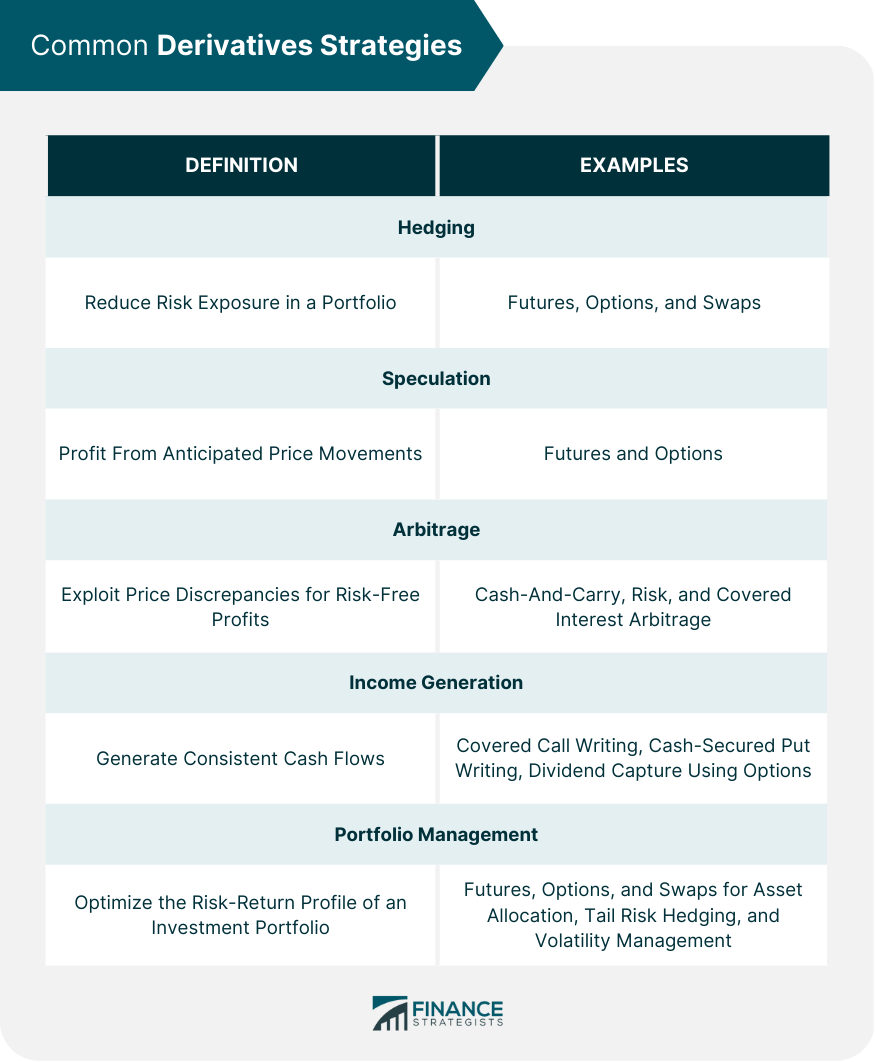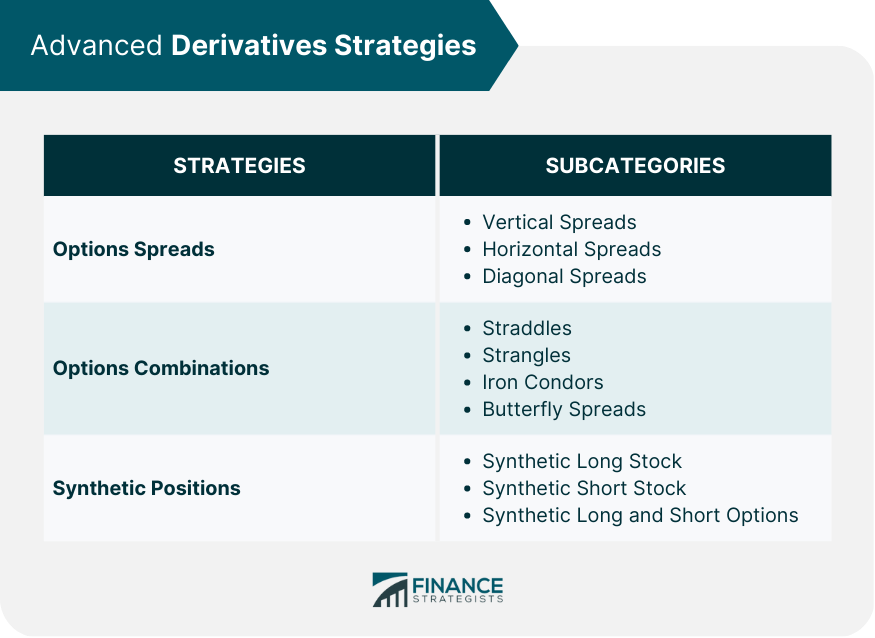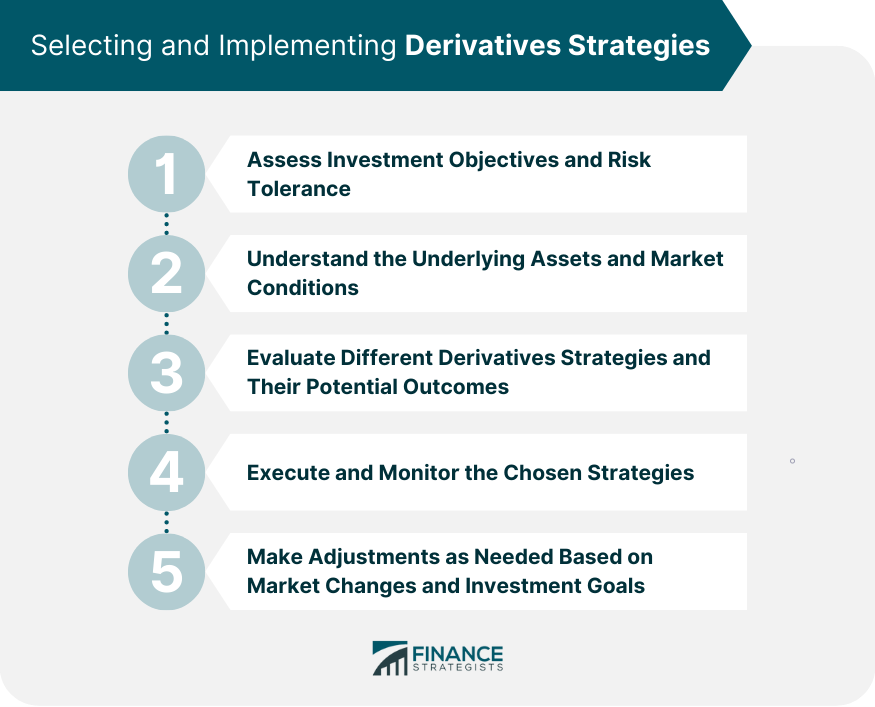Derivatives strategies involve using various derivative instruments, such as futures, options, swaps, and forward contracts. These strategies are designed to achieve specific investment objectives, such as hedging, speculation, arbitrage, income generation, and portfolio management. Derivatives are financial instruments whose value is derived from an underlying asset, index, or security. These instruments allow investors to manage risk, generate income, and speculate on market movements without owning the underlying asset. Derivatives strategies provide investors several benefits, including risk management, profit potential, cost efficiency, and flexibility. By employing these strategies, investors can protect their portfolios against adverse market movements, capitalize on market opportunities, and enhance overall investment performance. Futures are standardized contracts that obligate the buyer to purchase and the seller to sell a specific asset at a predetermined price and date. Futures contracts are traded on exchanges and are commonly used for hedging and speculation. Call options give the holder the right, but not the obligation, to buy an underlying asset at a specified price (the strike price) before the option's expiration date. Investors use call options to profit from an anticipated increase in the underlying asset's price. Put options grant the holder the right, but not the obligation, to sell an underlying asset at a specified price before the option's expiration date. Investors use put options to profit from an anticipated decline in the underlying asset's price or as a hedge against potential losses in their investment portfolios. Swaps are customized contracts between two parties that involve the exchange of cash flows or other financial instruments. Swaps can be used to hedge risks, such as interest rate or currency risk, or speculate on market movements. Forward contracts are customized agreements between two parties to buy or sell an asset at a predetermined price on a future date. Unlike futures contracts, forward contracts are not traded on exchanges and are typically used for hedging purposes. Hedging is a derivatives strategy that aims to protect an investor's portfolio from adverse market movements by reducing risk exposure. Hedging can involve using various derivative instruments, such as futures, options, and swaps, to offset potential losses in the underlying investments. Investors can use futures contracts to hedge their exposure to a specific asset or market by taking an opposite position in the futures market. For example, a producer of a commodity can sell futures contracts to lock in a specific price for their product, thus protecting against potential price declines. Options can be used to hedge an investor's exposure to an underlying asset by purchasing put options to protect against a decline in the asset's value or call options to protect against an increase in the cost of an asset. Options provide a more flexible hedging strategy, as they allow the investor to retain upside potential while limiting downside risk. Swaps can be used to hedge various types of risks, such as interest rate risk or currency risk. For example, an investor with exposure to floating interest rates can enter into an interest rate swap to exchange floating-rate payments for fixed-rate payments, effectively hedging against potential interest rate increases. Speculation is a derivatives strategy involving taking market positions to profit from anticipated price movements. Investors use derivative instruments, such as futures and options, to speculate on the direction of underlying asset prices, interest rates, or currency movements with the goal of generating profits. Investors can use futures and options contracts to speculate on the future price of an underlying asset. Investors can profit from an anticipated increase in the asset's price by taking a long position in a futures contract or purchasing a call option. Conversely, taking a short position in a futures contract or purchasing a put option allows investors to profit from an anticipated decline in the asset's price. Derivatives allow investors to leverage their investments, which means they can control a larger position in the market with a smaller amount of capital. Leveraging can magnify potential gains but also increases the risk of significant losses. Margin trading enables investors to borrow money from a broker to purchase securities, amplifying both potential gains and risks. While speculation can generate substantial profits, it also carries significant risks. Leveraging and margin trading can result in large losses if the market moves against the investor's position. Therefore, investors should carefully consider their risk tolerance and investment objectives before engaging in speculative derivatives strategies. Arbitrage is a derivatives strategy that involves the simultaneous purchase and sale of related financial instruments to exploit price discrepancies and generate risk-free profits. Arbitrage opportunities can arise due to market inefficiencies or mispricings and are often short-lived, as market participants quickly correct the price discrepancies. Cash-and-carry arbitrage involves the simultaneous purchase of an asset in the spot market and the sale of a corresponding futures contract. This strategy aims to profit from the difference between the spot and futures prices, which should converge as the futures contract expires. Risk arbitrage, also known as merger arbitrage, involves taking positions in the securities of companies involved in mergers and acquisitions. The strategy seeks to profit from the price discrepancies between the target company's stock price and the acquisition price offered by the acquiring company. Covered interest arbitrage is a strategy that involves exploiting differences in interest rates between two countries while eliminating currency risk. This is achieved by borrowing a currency with lower interest rates, exchanging the borrowed funds for a currency with higher interest rates, and investing the proceeds in an interest-bearing instrument. Income generation is a derivatives strategy that aims to generate consistent cash flows from investments in various financial instruments, such as options. Investors often use income-generating strategies to supplement their regular income or as a conservative approach to investing. Covered call writing involves holding a long position in an underlying asset and selling call options on the same asset. This strategy generates income from the premiums received from selling the call options and can provide downside protection in the event of a decline in the asset's price. Cash-secured put writing involves selling put options on an underlying asset while holding cash equivalent to the potential obligation of purchasing the asset at the option's strike price. This strategy generates income from the premiums received from selling the put options and can be used to acquire the underlying asset at a lower price if the option is exercised. The dividend capture strategy using options involves buying a stock before its ex-dividend date and selling call options on the same stock to generate income from the option premiums. This strategy aims to profit from the dividend payment and the option premiums while minimizing the risk of holding the stock for an extended period. Portfolio management is a derivatives strategy that aims to optimize the risk-return profile of an investment portfolio by using various financial instruments, such as futures, options, and swaps. Portfolio management strategies can help investors achieve specific investment objectives, such as diversification, risk reduction, and enhanced returns while adhering to their risk tolerance and financial goals. Derivatives can be used to adjust asset allocation and rebalance an investment portfolio without buying or selling the underlying assets. For example, investors can use futures contracts to increase or decrease their exposure to specific asset classes, such as stocks or bonds, or to hedge against potential market downturns. Tail risk hedging is a portfolio management strategy that aims to protect against rare but extreme market events, also known as "black swan" events, which can lead to significant losses. Investors can use options, such as out-of-the-money put options, to hedge against tail risk and limit the potential impact of extreme market movements on their portfolios. Volatility management is a derivatives strategy that involves using financial instruments, such as options or volatility derivatives, to manage the impact of market volatility on an investment portfolio. By reducing the portfolio's sensitivity to market fluctuations, investors can achieve more stable returns and reduce the risk of significant losses during periods of high volatility. Vertical spreads involve buying and selling options with the same expiration date but different strike prices. This strategy allows investors to limit risk while retaining profit potential. Vertical spreads can be bullish or bearish, depending on whether an investor uses call options or put options. Horizontal spreads, also known as calendar or time spreads, involve buying and selling options with the same strike price but different expiration dates. Investors can use horizontal spreads to profit from changes in options' time value or take advantage of differences in implied volatility. Diagonal spreads combine elements of both vertical and horizontal spreads, involving the purchase and sale of options with different strike prices and expiration dates. Investors can use diagonal spreads to capitalize on expected changes in the underlying asset's price and time value decay. A straddle involves buying a call option and a put option with the same strike price and expiration date. This strategy allows investors to profit from significant price movements in either direction, typically in anticipation of high volatility or significant market events. A strangle is similar to a straddle but involves buying out-of-the-money calls and put options with different strike prices. Strangles allow investors to profit from large price movements in either direction while requiring less upfront capital compared to a straddle. Iron condors involve selling an out-of-the-money call and put option while simultaneously buying a further out-of-the-money call and put option. This strategy generates income through the premiums received and profits when the underlying asset's price remains within a specific range. Butterfly spreads involve buying two options with different strike prices and selling two options with a strike price between the bought options. This strategy profits when the underlying asset's price remains close to the middle strike price, making it suitable for low-volatility environments. A synthetic long stock position involves buying a call option and selling a put option with the same strike price and expiration date. This strategy replicates the profit and loss potential of owning the underlying stock, providing investors with a cost-effective alternative to buying the stock outright. A synthetic short stock position is created by selling a call option and buying a put option with the same strike price and expiration date. This strategy replicates the profit and loss potential of short-selling the underlying stock, allowing investors to profit from a decline in the stock's price without actually shorting the stock. Synthetic long and short options positions involve combining options and the underlying asset to replicate the profit and loss potential of a long or short option position. These strategies can provide investors with additional flexibility and risk management opportunities in their portfolios. Counterparty risk arises when one party in a derivatives transaction fails to meet its obligations, potentially leading to financial losses. Investors can mitigate this risk by trading on regulated exchanges or using clearinghouses to guarantee the performance of the contracts. Market risk refers to the potential for losses due to fluctuations in market prices, interest rates, or other market factors. Investors can manage market risk through diversification, proper asset allocation, and the use of appropriate risk management strategies. Liquidity risk is the risk that an investor may not be able to buy or sell a derivative at a reasonable price or within a desired timeframe. Liquidity risk can be managed by trading in highly liquid markets or utilizing market makers to facilitate trades. Regulatory risk arises from changes in laws or regulations that may affect the value or viability of a derivatives strategy. Investors should stay informed about regulatory developments and consider the potential impact on their investment strategies. Operational risk refers to the risk of losses resulting from inadequate or failed internal processes, systems, or human factors. Investors can mitigate operational risk by conducting thorough due diligence on counterparties and using robust trading and risk management systems. Derivatives strategies can be complex and challenging to understand. The potential for significant losses exists if investors do not fully understand the mechanics of the strategies or fail to properly manage their risks. Before implementing any derivatives strategy, investors should assess their investment objectives and risk tolerance to ensure that the chosen strategy aligns with their goals and risk preferences. A thorough understanding of the underlying assets and prevailing market conditions is crucial when selecting and implementing derivatives strategies. Investors should research and analyze market trends, the macroeconomic environment, and specific asset characteristics. Investors should carefully evaluate various derivatives strategies' potential risks and rewards, considering factors such as market conditions, liquidity, and counterparty risk. Scenario analysis and stress testing can help investors assess the potential outcomes of different strategies under various market conditions. Once a derivatives strategy is selected, investors should precisely execute the trades and monitor their positions closely. Regular monitoring allows investors to identify potential issues or opportunities and make timely adjustments. Investors should be prepared to adjust their derivatives strategies in response to changing market conditions or shifts in their investment objectives. Flexibility and adaptability are essential for successful derivatives trading and risk management. A comprehensive understanding of derivatives strategies is essential for investors who wish to use these powerful financial instruments to achieve their investment objectives. A solid grasp of various strategies' mechanics, risks, and potential rewards is crucial for successful implementation and risk management. Derivatives strategies can offer numerous potential benefits, such as risk management, income generation, and enhanced investment performance. However, these strategies also carry inherent risks, including counterparty, market, and complexity. Investors should carefully weigh the potential benefits and risks before implementing any derivatives strategy. Continuous evaluation and management of derivatives strategies are crucial for maintaining optimal risk and return profiles. Investors should monitor their positions and market conditions closely, making adjustments as needed to respond to changes in their investment objectives or market conditions. Investors who are interested in using derivatives strategies to achieve their financial goals may benefit from seeking professional wealth management services. A wealth manager can help investors understand the intricacies of derivatives strategies, assess their suitability for their investment objectives, and provide guidance on implementation and risk management.What Are Derivatives Strategies?
Types of Derivatives
Futures
Options
Call Options
Put Options
Swaps
Forward Contracts

Common Derivatives Strategies
Hedging
Speculation
Arbitrage
Income Generation
Portfolio Management

Advanced Derivatives Strategies
Options Spreads
Vertical Spreads
Horizontal Spreads
Diagonal Spreads
Options Combinations
Straddles
Strangles
Iron Condors
Butterfly Spreads
Synthetic Positions
Synthetic Long Stock
Synthetic Short Stock
Synthetic Long and Short Options

Risks and Considerations of Derivatives Strategies
Counterparty Risk
Market Risk
Liquidity Risk
Regulatory Risk
Operational Risk
Complexity and Potential for Losses
Selecting and Implementing Derivatives Strategies

Assessing Investment Objectives and Risk Tolerance
Understanding the Underlying Assets and Market Conditions
Evaluating Different Derivatives Strategies and Their Potential Outcomes
Executing and Monitoring the Chosen Strategies
Making Adjustments as Needed Based on Market Changes and Investment Goals
Final Thoughts
Derivatives Strategies FAQs
Derivatives strategies involve using various derivative instruments, such as futures, options, swaps, and forward contracts, to achieve specific investment objectives, such as hedging, speculation, arbitrage, income generation, and portfolio management.
Derivatives strategies carry inherent risks, including counterparty, market, liquidity, regulatory, operational, and complexity risks. Investors should carefully weigh the potential benefits and risks before implementing any derivatives strategy.
Investors can mitigate counterparty risk by trading on regulated exchanges or using clearinghouses to guarantee the performance of the contracts.
The steps involved in selecting and implementing derivatives strategies include assessing investment objectives and risk tolerance, understanding the underlying assets and market conditions, evaluating different derivatives strategies and their potential outcomes, executing and monitoring the chosen strategies, and making adjustments as needed based on market changes and investment goals.
Derivatives strategies provide investors several benefits, including risk management, profit potential, cost efficiency, and flexibility. By employing these strategies, investors can protect their portfolios against adverse market movements, capitalize on market opportunities, and enhance overall investment performance.
True Tamplin is a published author, public speaker, CEO of UpDigital, and founder of Finance Strategists.
True is a Certified Educator in Personal Finance (CEPF®), author of The Handy Financial Ratios Guide, a member of the Society for Advancing Business Editing and Writing, contributes to his financial education site, Finance Strategists, and has spoken to various financial communities such as the CFA Institute, as well as university students like his Alma mater, Biola University, where he received a bachelor of science in business and data analytics.
To learn more about True, visit his personal website or view his author profiles on Amazon, Nasdaq and Forbes.















